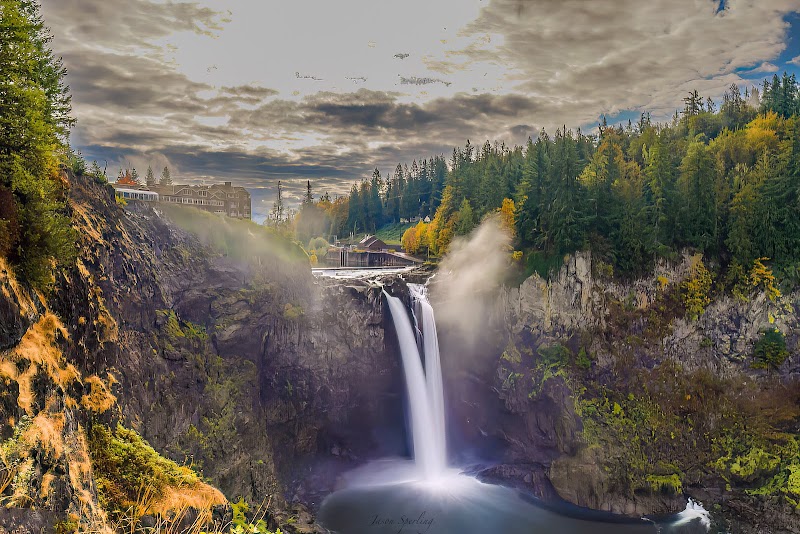
Exploring Environmental Attractions Near Snoqualmie, Washington: A Practical Outdoor Guide
Discover the environmental attractions near Snoqualmie, Washington, where powerful waterfalls and tranquil forest trails offer a balanced outdoor experience. From the thunderous Snoqualmie Falls to peaceful hike paths, gear up to explore this dynamic natural region.
Wear Grippy, Waterproof Footwear
Trails near Snoqualmie Falls can be slick from mist and rain. Hiking boots with waterproofing and good traction help prevent slips on wet rocks and uneven terrain.
Bring Plenty of Water
Hydration is critical, especially in spring and summer when trails heat up quickly. Carry at least 2 liters per person and refill when possible at park facilities.
Plan for Weather Changes
The Pacific Northwest can shift from sun to rain rapidly. Layered clothing is vital to stay comfortable and dry during your hike near Snoqualmie.
Visit Early or Late to Avoid Crowds
Snoqualmie Falls attracts many visitors. Arriving early morning or late afternoon allows a quieter encounter with the natural environment and better photo conditions.
Exploring Environmental Attractions Near Snoqualmie, Washington: A Practical Outdoor Guide
Snoqualmie, Washington, offers an engaging array of environmental attractions that invite visitors to connect with the Pacific Northwest’s wild heart. From the iconic Snoqualmie Falls, where water roars with relentless energy as it tumbles 268 feet into a narrow gorge, to forest trails that thread through Douglas firs and cedars, this region blends natural power and serene wilderness. These spots demand attention not just for their scenic beauty but for the challenging and immersive outdoor experiences they provide.
The Snoqualmie Falls Park trail is a must-visit. It’s a 1.5-mile loop with a moderate elevation gain of about 300 feet, traversing mixed terrain that includes paved path sections and natural dirt trails. Prepare for slippery rocks near the falls’ viewing platforms, especially after rain; sturdy footwear and steady footing are essential. The falls themselves dare you to come closer, their persistent mist pushing against you with every gust.
Nearby, the Snoqualmie Ridge forest paths offer quieter hikes through old-growth stands, where moss-draped limbs and trickling streams narrate the forest’s story. Trails range from easy to moderate, suited for casual walkers and seasoned adventurers alike. These routes provide opportunities for birdwatching and spotting elusive creekside wildlife.
Planning your visit? Timing is key. Spring and early summer deliver vibrant wildflowers and rushing meltwater, while fall drapes the forest in fiery colors but demands preparedness for wetter conditions. Winter offers snow-dusted views but requires caution and proper gear.
Keywords optimized here include environmental attractions, Snoqualmie waterfalls, Pacific Northwest hiking, Snoqualmie outdoor activities, eco-tourism in Washington, Snoqualmie Falls trail, forest hikes Snoqualmie, and adventure travel Snoqualmie. These terms align with what outdoor enthusiasts search for when seeking both thrilling landscapes and practical hiking details in this region.
Beyond sightseeing, Snoqualmie is a gateway to immersive environmental experiences that honor the fierce, ever-changing nature of the land. Whether you’re tracking the falls’ roar or threading forest paths, the adventure is informed by respect and readiness, delivering both exhilaration and understanding of this vivid landscape.
Nearby Trips
All Adventures
Boat Charters
Water Activities
Adventures near Snoqualmie, Washington
Discover the unique and memorable adventures that make Snoqualmie, Washington special.
Frequently Asked Questions
What is the best viewpoint to see Snoqualmie Falls safely?
The upper viewing platform accessed via the parking lot offers the safest and most complete views of the entire 268-foot waterfall. Railings and walkways are maintained to ensure visitor safety.
Are dogs allowed on trails near Snoqualmie Falls?
Dogs are permitted on leash throughout the park and nearby forest trails. Be mindful of wildlife and carry water for your pet, especially during warmer seasons.
What wildlife might I encounter during hikes around Snoqualmie?
Visitors commonly spot black-tailed deer, various songbirds, and occasionally river otters near watercourses. Keep a respectful distance and avoid feeding animals.
Is there an entrance fee for Snoqualmie Falls Park?
Currently, Snoqualmie Falls Park does not charge an entrance fee, making it an accessible outdoor destination for all levels of adventurers.
Are there guided tours available to explore environmental attractions near Snoqualmie?
Yes. Several local outfitters provide guided hikes and eco-tours focused on the area's natural history, flora, and geology, offering deeper educational insight.
Can I swim near Snoqualmie Falls or adjacent streams?
Swimming directly below Snoqualmie Falls is prohibited due to strong currents and hazardous terrain. However, some nearby calmer creek areas may be suitable for wading under supervision.
Recommended Gear
Waterproof hiking boots
Protect feet from wet terrain while providing necessary grip on slick rocks and forest trails.
Layered clothing
Adjust for sudden weather changes with moisture-wicking base layers and waterproof outer layers.
Hydration pack or water bottles
Stay hydrated through vigorous activity, especially during warmer months.
Trekking poles
Aid balance on uneven or slippery terrain, reducing strain on knees during elevation changes.
Local Insights
Hidden Gems
- "Bridal Veil Falls Trail, a quiet path offering a less crowded but equally scenic waterfall experience."
- "Jensen Creek Trail, featuring old-growth forest and seasonal wildflowers just a short drive from Snoqualmie Falls."
Wildlife
- "Northern spotted owls"
- "Black-tailed deer"
- "Pacific tree frogs"
History
"Snoqualmie Falls has long been sacred to the Snoqualmie Tribe, serving as a key spiritual and cultural site. The surrounding forests were historically important for logging, shaping both the human and environmental story of the region."